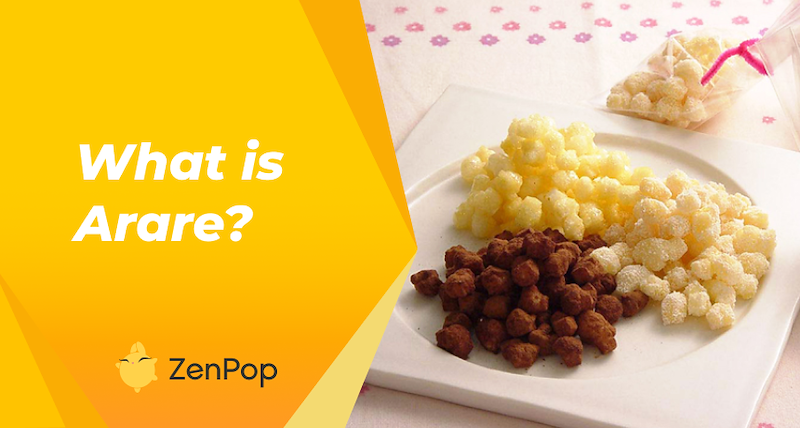
</title><meta name="robots" content="noindex"> What is Arare?
Japan has an abundance of traditional glutinous rice-based snacks, and among them is a snack called arare (あられ), which is a type of rice cracker. Eating arare is like munching on popcorn as each one is sized like a hailstone (hence, the name). But you can also find them in smaller or bigger bits.
The Japanese rice cracker comes in different types and flavors. Some are savory while others are sweet. If you want to try this crunchy snack and explore what makes arare worth a try, let this post be your guide.
What is arare made of?
Glutinous rice is the major ingredient of arare. Its base flavor is either soy sauce or sugar. Some arare makers mix other ingredients such as nori, matcha powder, sesame seeds, and peanuts.
How arare is made
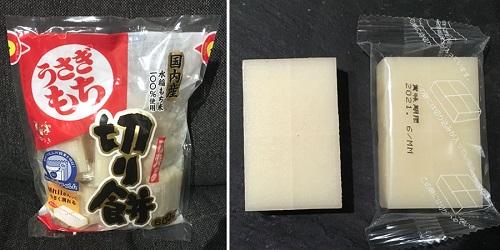
Kirimochi, an ingredient used when making homemade arare
When making arare from scratch, it would take about three to seven days as the glutinous rice needs to be dried for a couple of days before it can be oil fried.
If you want to make one at home, you just need to buy kiri mochi (切り餅) or cut rice cake. You’ll likely find them in Asian groceries or your favorite online store. Homemade arare can be pan-fried or oven-baked.
Arare vs. Senbei

Both arare and senbei (煎餅) are traditional Japanese rice crackers, but what makes them different is their main ingredient and shape.
- Senbei is made from uruchi-mai (うるち米), which is non-glutinous rice. Before the preparation of the cracker, this ingredient is steamed and pounded. Small round pieces are cut from the through and then baked to finally make senbei.
- Arare, on the other hand, uses mochigome (もち米), which is sticky glutinous rice. It is often confused with okaki (おかき) because this rice cracker uses the same ingredient and cooking process. To determine whether or not it’s arare, you only need to look at the shape. Okaki are always bigger while arare are popcorn-sized bits, with each one measuring around 2 to 3 centimeters.
Types of Arare
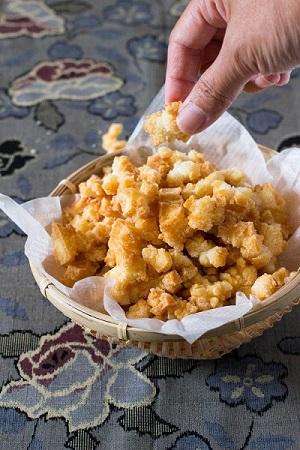
The best thing about arare is that it can suit different taste preferences. Although they’re usually sweet or savory, they’re available in different flavors.
Most varieties are enjoyed as snacks, but the salty ones can also be served as otsumami (おつまみ) or appetizers that go well with alcoholic drinks. The sweet ones are usually seen on special occasions. Let’s explore the different types of arare.
Hina Arare
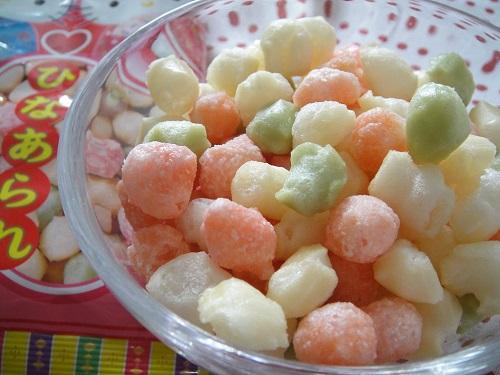
Hina arare is the most colorful Japanese rice cracker on this list. The puffs typically come in colors that represent the four seasons: pink, green, yellow, and white.
Since hina arare is served during Hina Matsuri, a holiday dedicated to young girls in Japan, you can already expect that it tastes sweet. It is cooked in sugar and then added with color powder (some of which are flavored).
Hina Matsuri (also called Doll’s Day or Girls’ Day) is a traditional festival celebrated every 3rd of March in the country. The celebration of Chinese origin is dedicated to wishing for the good health of girls. It has been celebrated in the country for more than a thousand years.
How to Make Hina Arare at Home
Here’s an easy way to make homemade hina arare. This recipe serves the snack in three colors. Try it out!
Ingredients:
- 2 pieces kirimochi (cut mochi)
- 2 tablespoons beet sugar
- 1 ½ tablespoons water
- 1 teaspoon strawberry powder
- ⅓ teaspoon matcha powder
Procedure:
- Take a piece of kirimochi and cut it into 5-mm squares. Do the same to the other piece.
- On a baking tray lined with parchment paper, place the kirimochi squares, separating them at a uniform distance to prevent them from sticking to each other.
- At 150 degrees, bake the kirimochi for 20 minutes.
- Kirimochi pieces swell when cooked so they still tend to stick with each other. Once the pieces have cooled down, separate them from one another.
- In a frying pan, add sugar and water. Cook over medium heat.
- Swirl the pan to prevent crystallization. Heat the mixture until it thickens.
- Turn the heat off then add the baked kirimochi pieces. Mix while the sugar and water mixture is hot.
- Place the kirimochi pieces on a tray with parchment paper and let them cool down. Afterward, divide them into three equal amounts.
- Place 1/3 in a plastic bag. Add the strawberry powder then shake.
- Do the same thing with the matcha powder. Don’t put too much matcha powder as it might make your hina arare bitter.
- Serve and enjoy your sweet hina arare!
Kaki No Tane
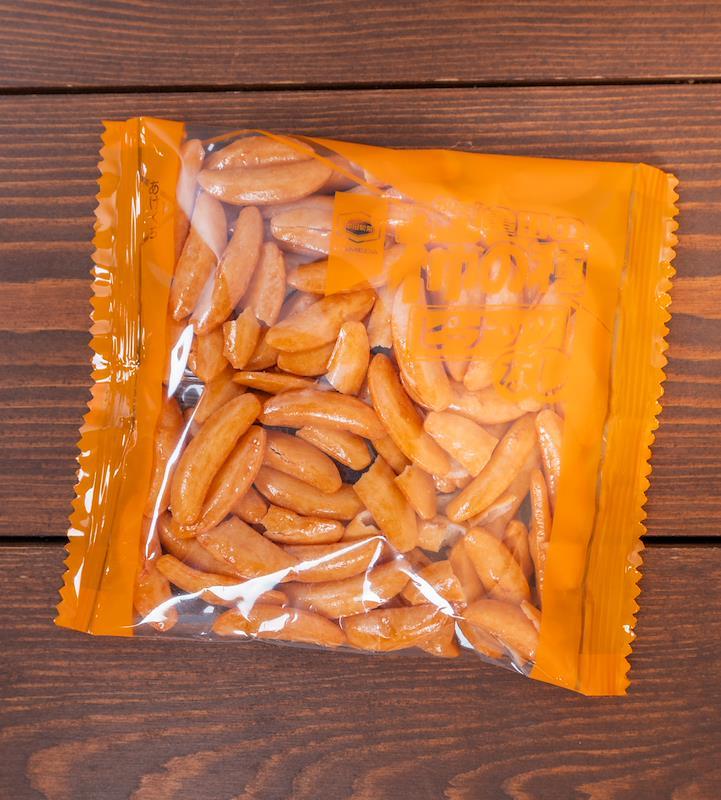
Kaki no tane is the most popular arare variety in Japan. What makes it unique from other types of arare is its crescent shape that resembles persimmon (kaki) seeds.
The reddish-orange color of the original kaki no tane comes from the combination of its ingredients, which include soy sauce, chili powder, and food coloring. It is also sold in different flavors, such as wasabi, chocolate, umeboshi, curry, and more.
A number of manufacturers in Japan produce this rice cracker, but the most common kaki no tane are the ones from Kaneda. This is the brand that popularized kaki-pi/kaki-pea, which mixes rice crackers with peanuts.
Kaki no tane is an excellent otsumami with its umami and slightly spicy flavor combination. Kaki no tane goes well with Japanese beer and other alcoholic drinks served at izakayas.
Norimaki Arare
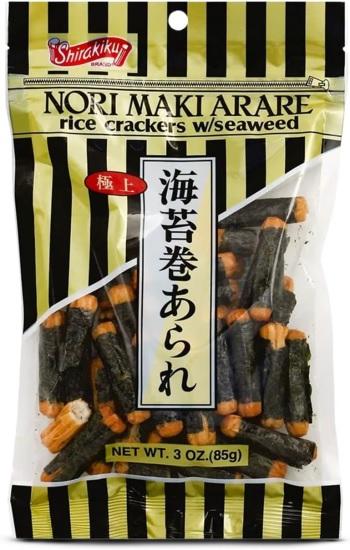
Nori or seaweed is a flavor a lot of people love about Japanese food. And if you’re looking for this taste in arare, norimaki arare is your best choice. Each cracker is rectangular shaped with nori wrapped around it with both ends poking out. It has a satisfying crisp and mouth-watering aroma.
The classic Japanese rice cracker is a great otsumami with its savory taste, so go ahead and serve it with beer. Norimaki Arare is also an excellent combo with tea. Serve it during your afternoon snack break.
Kotsubukko
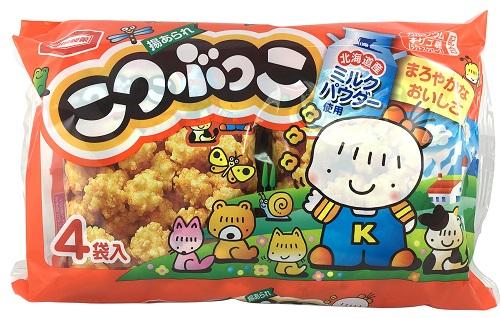
People who love fried food will surely like kotsubukko, the fried version of arare. Just like the typical arare, it is made savory with soy sauce. But it has notes of honey which creates a gentle sweet taste.
The golden brown treats look a lot like popcorn. Since the cracker is deep-fried, kotsubukko will delight you with its satisfying crunch.
Conclusion
Believe it or not, arare has been enjoyed in Japan since the Edo period (1603 to 1867). It continues to be a well-loved snack with its unique texture and delightful taste. Arare crackers will surely satisfy everyone’s taste as they come in unique sweet and savory flavors.
Check out our latest Japanese snack box where we may include some typical Japanese arare!

